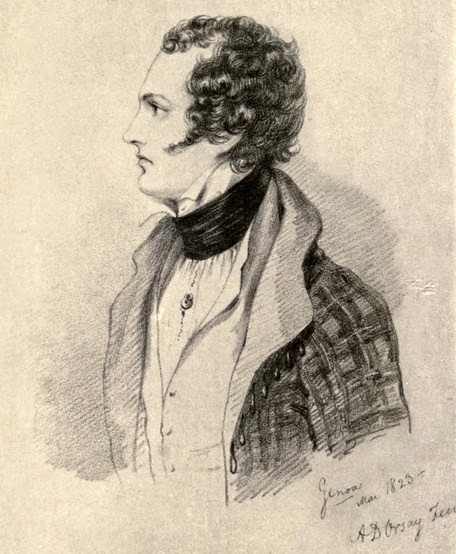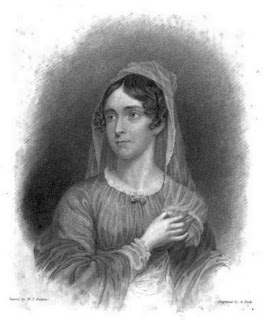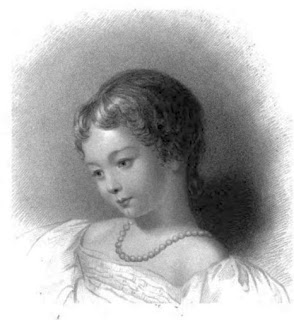 |
| Lord Byron by Stanfield from Life, Letters and Journals of Lord Byron (1839) |
George Gordon Noel Byron, 6th Baron Byron (22 January 1788 - 19 April 1824), was a leading poet in the Romantic Movement. His most famous works include The Pilgrimage of Childe Harold and Don Juan.
Family life
George Gordon Byron was born in London on 22 January 1788, the son of Captain John Byron and his second wife, Catherine Gordon. There was one child from his father’s previous marriage, Augusta. Captain 'Mad Jack' Byron was a reckless man who had married Byron’s mother for her money. He soon left his family and died in 1791. Byron lived in Aberdeen with his highly volatile mother.
Education
Byron attended school in Aberdeen, Dulwich and Harrow before going up to Trinity College, Cambridge, in 1805. One of his more eccentric actions was to keep a tame bear in the tower above his rooms. Here he formed many lasting friendships, in particular, those with William John Bankes, John Cam Hobhouse and Scrope Berdmore Davies.
Lord Byron
In 1794, Byron unexpectedly became heir to his uncle on the death of his cousin. He inherited the title on his uncle’s death on 21 May 1798, becoming the 6th Baron Byron.
On the death of his mother-in-law, Lady Noel, in January 1822, Byron took the name Noel.
Newstead Abbey
 |
| Newstead Abbey from The Life of Byron by Thomas Moore (1849) |
Byron liked to entertain his friends whilst staying at the Abbey. He wrote: “We went down to Newstead together, where I had got a famous cellar, and Monks’ dresses from a masquerade warehouse…drinking burgundy, claret, champagne, and what not, out of the skull-cup, and all sorts of glasses..”(1)
He sold Newstead Abbey in November 1818 for £94,500.
Poetry
In June 1807, Byron’s first volume of poetry, Hours of Idleness, was published. In February 1808, the Edinburgh Review ridiculed both the poems and their author. Byron was distraught and in response, he wrote his first satirical poem, English Bards and Scotch Reviewers, which was published in March 1809.
Parliament
Byron took his seat in the House of Lords on 13 March 1809 as a Whig supporter. He made two speeches in the House, both in favour of reform.
The Grand Tour
On 2 July 1809, Byron left England with his friend Hobhouse and went on the Grand Tour. His travels included Lisbon and Malta, Albania and Greece, Smyrna, Ephesus and Constantinople. He returned to England two years later, arriving in Portsmouth on 14 July 1811.
Childe Harold
 |
| Lord Byron from A Journal of the Conversations of Lord Byron with the Countess of Blessington (1893) |
“I awoke one morning and found myself famous.”(2)Disabled sportsman
Byron was born with a lame right foot which caused him considerable pain when well-intentioned doctors tried to cure it.
Despite his lameness, Byron was a keen sportsman. He was particularly good at diving and swimming.
Whilst on the Grand Tour, on 3 May 1810, he repeated Leander’s legendary feat of swimming the Hellespont from Sestos to Abydos.
Byron’s affairs
Byron was fatally attractive to women.
“Of his face, the beauty may be pronounced to have been of the highest order, as combining at once regularity of features with the most varied and interesting expression.”(3)His affairs were numerous and his lovers included: Julia Leacroft; Mrs Constance Spencer Smith; Lady Caroline Lamb, wife of William Lamb, later Viscount Melbourne; Lady Oxford; Claire Clairmont, Mary Shelley’s step-sister; Marianna Segati; Margarita Cogni; and Countess Teresa Guiccioli.
 |
| Lady Caroline Lamb from Wives of the Prime Ministers (1844-1906) |
Byron was also very close to his half-sister, Augusta Leigh. It was rumoured that they had an incestuous relationship and that Augusta’s daughter Medora, born in 1814, may have been fathered by Byron.
Lady Byron
 |
| Lady Byron from The Works of Lord Byron (1833) |
Mad?
Lady Caroline Lamb described Byron as “Mad, bad and dangerous to know”(4). After his marriage, Byron seemed determined to prove the truth of these words to his new wife. He started behaving erratically and flaunted his past affairs in her face. But worst of all, he hinted at the nature of his relationship with Augusta, alarming both his wife and his sister.
Lady Byron became convinced that he was mad. She gave birth to a daughter, Augusta Ada, on 10 December 1815 and a month later, on 15 January 1816, she left with the baby on a visit to her parents. Byron never saw his wife or daughter again.
 |
| Ada Byron from Letters and Journals of Lord Byron (1833) |
Exile
Byron travelled through Switzerland and Italy. In Geneva he met Percy Shelley and his wife, Mary, and her step-sister Claire Clairmont, with whom he had indulged a brief affair back in London and who was now pregnant with his child. One wet night, they wrote ghost stories together, resulting in Mary Shelley’s masterpiece, Frankenstein.
Clara Allegra Byron
Claire Clairmont gave birth to Byron’s daughter, Clara Allegra, on 12 January 1817. Hoping to give her daughter a more secure future, she gave Allegra into Byron’s care. Tragically, Allegra died at the convent where she was residing on 20 April 1822, aged five.
Don Juan
Byron wrote the first canto of Don Juan and sent it to his publisher, Murray, who declared that it was “unpublishable”. He eventually yielded, under threat of losing such a lucrative writer, but further arguments between them led to Byron later changing his publisher to John Hunt. Don Juan was extremely readable and proved to be very popular.
The Carbonari
In 1819, Byron embarked on an affair with Countess Teresa Guiccioli. Teresa’s father was involved with the Carbonari, a secret revolutionary group, and Byron’s political zeal was rekindled. When the insurrection failed in 1821, the disillusioned Byron moved to Pisa with Teresa’s family and the Shelleys. More grief followed. On 8 July 1822, Percy Shelley was drowned.
Political activist
In 1823, Byron was persuaded to join the cause for Greek independence. He sailed for Greece, funding a small military force with his own money. He was dismayed to find that the revolutionary leaders were not united, making progress difficult.
Byron joined forces with Prince Alexander Mavrocordatos in Missolonghi on 4 January 1824 and started to plan an assault on Lepanto. However, on 15 February(2), Byron had a violent convulsion, and though he seemed to recover, the assault had to be abandoned.
Illness and death
But Byron’s constitution had been irreparably weakened. He became ill with fever and died on 19 April 1824. Despite his own wishes to be buried in Greece, his body was sent home to England, arriving on 29 June.
 |
| Memorial in Hucknall Church from The Works of Lord Byron (1833) |
His body lay in state on 9-10 July and then a funeral procession consisting of 47 carriages, accompanied Byron’s hearse out of London. He was buried in the family vault in Hucknall Church near Newstead.
 |
| Hucknall Church from The Works of Lord Byron (1833) |
More details of his relationship with Lady Caroline Lamb here.
Notes
(1) In a letter to Murray from Ravenna (1820) in Thomas Moore's The Life of Lord Byron (1844).
(2) From Life, Letter and Journals of Lord Byron ed Thomas Moore (1839).
(3) From Thomas Moore's The Life of Lord Byron (1844).
(4) From Lady Caroline's diary recorded in Oxford Dictionary of National Biography, Lady Caroline Lamb by Caroline Franklin (2005)
Sources used include:
Byron, George Gordon, Baron, The Works of Lord Byron (1833)
Byron, George Gordon, Baron and Moore, Thomas, Life, Letters and Journals of Lord Byron (1839)
Franklin, Caroline, Lamb, Lady Caroline (1785-1828), Oxford Dictionary of National Biography (Oxford University Press, 2004; online edn, Oct 2005, accessed 28 Nov 2012)
McGann, Jerome, Byron, George Gordon Noel, 6th Baron Byron (1788-1824) Oxford Dictionary of National Biography (Oxford University Press, 2004; online edn Oct 2009, accessed 2 Jul 2013)
Moore, Thomas, The Life of Lord Byron (1844)

I grew up very close to Newstead Abbey and have spent innumerable happy days there; a truly beautiful place.
ReplyDeleteI have never been there - I will have to put it on my "to visit" list.
DeleteThank you for this post Rachel... I always get a great 'buzz' when someone else 'Blogs Byron'... Regards, Tee
DeletePS: You will love Newstead, it's one of my favourite places on earth!
Thank you - it means a lot to have the approval of a Byron expert :)
DeleteGeorge Byron, what a life! The perfect subject for movies and romances
ReplyDeleteBut no happy ending :(
DeleteSo interesting...thanks for sharing...
ReplyDeleteThank you for saying that his affair with his half sister was a rumor. It has never been proven and some of the so called proofs exist only in the minds of some of the people. Ever since Byron returned to England in 1811, he had been planning to return. He planned a journey in 1814., but there was a plague in one of the islands where they were to land so the journey was postponed. He had secured berths for himself and his servant before he had to cancel. I think his wife knew of his plans and didn't plan to accompany him. She had her daughter made a ward in Chancery so Byron couldn't take her to the continent. If there were rumors or scandals before he left England they were only in small circle and had a short life. Lady Caroline Lamb is suspected there. Byron's poetry is in danger of being overlooked because of the attention paid to his sex life.
ReplyDeleteI think it is hard for us to realise how a poet could be so famous because poetry is nowhere near so popular today. Although there is a danger that Byron's private life overshadows his poetry, I doubt whether many people would know he existed if he had not been such a successful poet in the first place.
DeleteTotally mismatched as a married couple. No romance writer would have paired them.
ReplyDeleteRead his letters and Journals as well as Don Juan.
I quite agree and can't help wondering how much influence Lady Melbourne exerted to promote the match.
Delete